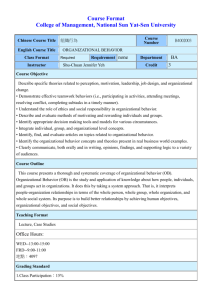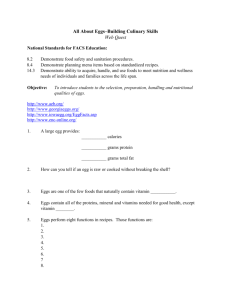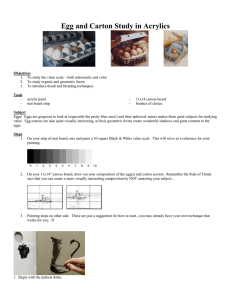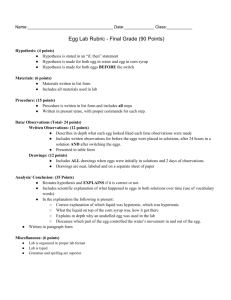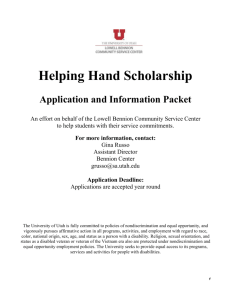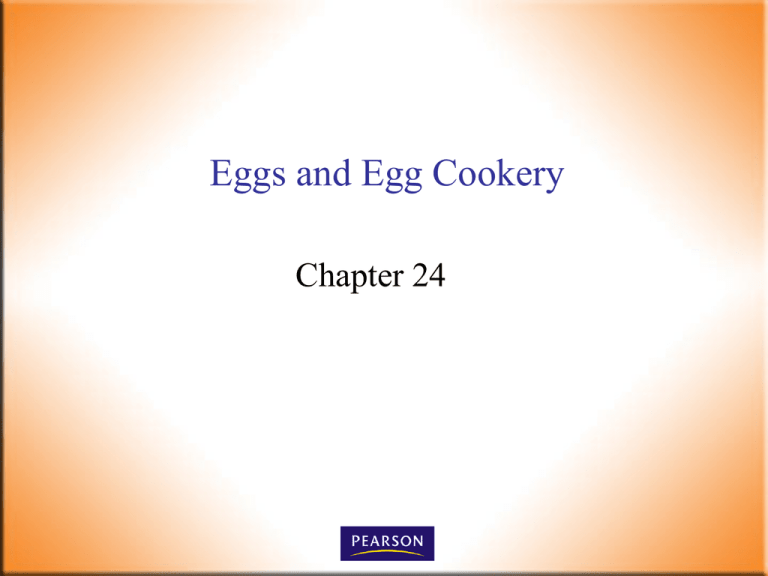
Eggs and Egg Cookery
Chapter 24
Use of Eggs
Emulsions (Lecithin in yolk)
Foam
Coagulation
Clarifying agent
Color
Flavor
Introductory Foods, 13th ed.
Bennion and Scheule
2
© 2010 Pearson Higher Education,
Upper Saddle River, NJ 07458. • All Rights Reserved.
Composition
Whole Eggs
75% water
12% protein
10% fat
1% carbohydrate
1% minerals
Egg White
Egg Yolk
Introductory Foods, 13th ed.
Bennion and Scheule
3
88% water
4g protein
0g fat
Trace minerals
49% water
3g protein
5g fat
© 2010 Pearson Higher Education,
Upper Saddle River, NJ 07458. • All Rights Reserved.
Nutritive Value
Protein
High protein efficiency
ratio (PER)
Whites
Triglycerides
Phospholipids
Cholesterol
Ovalabumin
Yolks
Lipids
Lipoproteins
Pigments
Introductory Foods, 13th ed.
Bennion and Scheule
4
Xanthophyll
Vitamin A
© 2010 Pearson Higher Education,
Upper Saddle River, NJ 07458. • All Rights Reserved.
Air cell
Chalazae
Shell
Yolk
Vitelline Membrane
Thick White
Thin white
Basic parts of the egg
Introductory Foods, 13th ed.
Bennion and Scheule
5
© 2010 Pearson Higher Education,
Upper Saddle River, NJ 07458. • All Rights Reserved.
Structure
Egg Shell
Porous
Shell color has no impact (flavor or nutrition)
Protective coating
Allows exchange of gas and moisture
Cuticle or Bloom
Replaced with oil after washing
Air Cells
Become larger as egg ages
Introductory Foods, 13th ed.
Bennion and Scheule
6
© 2010 Pearson Higher Education,
Upper Saddle River, NJ 07458. • All Rights Reserved.
Structure
Albumen
Chalazae
Egg white
Consists of thick and thin portions
Thickened “rope-like” white that anchors yolk
Membranes
Thin membrane that surrounds yolk
Shell membranes
Introductory Foods, 13th ed.
Bennion and Scheule
7
© 2010 Pearson Higher Education,
Upper Saddle River, NJ 07458. • All Rights Reserved.
Structure
Yolk
Composed of protein granules and oil droplets
within spheres
Germinal disc
No difference between fertile and infertile eggs
Blood spots
Introductory Foods, 13th ed.
Bennion and Scheule
Because of blood vessel rupture on surface of yolk
8
© 2010 Pearson Higher Education,
Upper Saddle River, NJ 07458. • All Rights Reserved.
Egg Quality
Fresh eggs
Stand high when broken
onto a plate
Yolk stands high and round
Two “layers” of egg white
evident
Small air cells
Yolks are slightly acidic
Older egg
Introductory Foods, 13th ed.
Bennion and Scheule
9
Spreads out when broken
onto a plate
Yolk does not stand high
and round
One “layer” of white that
spreads out
Large air cells
Egg becomes more alkaline
© 2010 Pearson Higher Education,
Upper Saddle River, NJ 07458. • All Rights Reserved.
Egg Flavor and Odor
Affected by
Feed
Hen
Storage
Introductory Foods, 13th ed.
Bennion and Scheule
10
© 2010 Pearson Higher Education,
Upper Saddle River, NJ 07458. • All Rights Reserved.
Purchasing & Quality
Purchasing
Pack date
USDA grading
Quality measurement
U.S. Grade AA, Grade A, or Grade B
Candling
Sizing
Recipes standardized for large eggs
Consider cost of eggs per dozen
Introductory Foods, 13th ed.
Bennion and Scheule
11
© 2010 Pearson Higher Education,
Upper Saddle River, NJ 07458. • All Rights Reserved.
Food Safety
1 out of 20,000 eggs contaminated with Salmonella
enteritidis
About 2.3 million eggs contaminated
Unbroken eggs may be contaminated
Raw or undercooked eggs implicated in about 80
percent of foodborne illness outbreaks
Introductory Foods, 13th ed.
Bennion and Scheule
12
© 2010 Pearson Higher Education,
Upper Saddle River, NJ 07458. • All Rights Reserved.
Regulation & Processing
Safe food handling instructions must be on
cartoons
Eggs must be held and displayed at or below
45°F (7°C)
Some eggs may be
Pasteurized
Irradiated
Introductory Foods, 13th ed.
Bennion and Scheule
13
© 2010 Pearson Higher Education,
Upper Saddle River, NJ 07458. • All Rights Reserved.
Recommendations
Avoid cross-contamination with raw eggs
Do not eat raw eggs
Cook over moderate heat
Use pasteurized eggs for high-risk populations
Introductory Foods, 13th ed.
Bennion and Scheule
14
© 2010 Pearson Higher Education,
Upper Saddle River, NJ 07458. • All Rights Reserved.
Preservation and Processing
Processed egg products
Frozen
Yolks frozen with salt or sugar for stabilization
Dried
Liquid
Other
Pasteurization required of all processed eggs
Introductory Foods, 13th ed.
Bennion and Scheule
15
© 2010 Pearson Higher Education,
Upper Saddle River, NJ 07458. • All Rights Reserved.
Egg Substitutes
Provide a low-cholesterol egg product
Contain
No or very little yolk
High concentration of egg white
Additional ingredients may include
Corn or soybean oil
Nonfat dry milk
Soy protein isolate
Egg white solids
Calcium caseinate
Introductory Foods, 13th ed.
Bennion and Scheule
16
© 2010 Pearson Higher Education,
Upper Saddle River, NJ 07458. • All Rights Reserved.
Heat Coagulation
Heat denatures egg proteins
Proteins aggregate into a three dimensional gel
network
Network stabilized by cross bonds
Disulfide bonds
Hydrogen bonds
Coagulation proceeds gradually
Introductory Foods, 13th ed.
Bennion and Scheule
17
© 2010 Pearson Higher Education,
Upper Saddle River, NJ 07458. • All Rights Reserved.
Heat Coagulation
Egg yolks vs. egg whites
Diluted eggs (i.e. diluted with milk)
High temperatures
Promote toughness and shrinking
Rapid heating
Influence of the addition of
Sugar, Salt, Acid
Introductory Foods, 13th ed.
Bennion and Scheule
18
© 2010 Pearson Higher Education,
Upper Saddle River, NJ 07458. • All Rights Reserved.
Coagulation by Beating
Beating causes part of the proteins to become
coagulated
Egg whites
Whole eggs
Become foamy, then form soft and stiff peaks
Over beaten – then dry and flocculated
Will beat stiffer
Egg yolks
Increase slightly in volume
Introductory Foods, 13th ed.
Bennion and Scheule
19
© 2010 Pearson Higher Education,
Upper Saddle River, NJ 07458. • All Rights Reserved.
Egg White Foams
Thin whites – more fluffy, less body
Thick whites – more stable foam
Room temperature – greater volume
Fine beater wires – finer air cells
Bowl type
Introductory Foods, 13th ed.
Bennion and Scheule
20
© 2010 Pearson Higher Education,
Upper Saddle River, NJ 07458. • All Rights Reserved.
Egg White Foams
Impact of added substances
Fat
Salt
decrease volume and stability
Acid (Cream of Tartar)
interferes
increases stability
Increases whipping time
Sugar
Introductory Foods, 13th ed.
Bennion and Scheule
increases beating time
Increases stability
21
© 2010 Pearson Higher Education,
Upper Saddle River, NJ 07458. • All Rights Reserved.
Egg Preparation Methods
Poached
Cooked in shell
Fried eggs
Scrambled eggs
Shirred eggs
Omelets
French
Puffy
Introductory Foods, 13th ed.
Bennion and Scheule
Crêpes
Soufflés
Custard
22
Baked
Soft or Stirred
Meringues
Microwave cooking
© 2010 Pearson Higher Education,
Upper Saddle River, NJ 07458. • All Rights Reserved.
Why do eggs turn green!
Overcooking
Held hot – too long
Older (more alkaline eggs) are more
susceptible
Green color caused by
Reaction of iron in yolk with hydrogen sulfide
in white to produce ferrous sulfide
Introductory Foods, 13th ed.
Bennion and Scheule
23
© 2010 Pearson Higher Education,
Upper Saddle River, NJ 07458. • All Rights Reserved.


